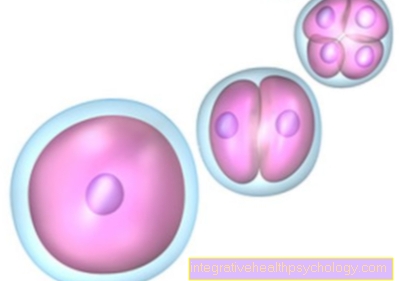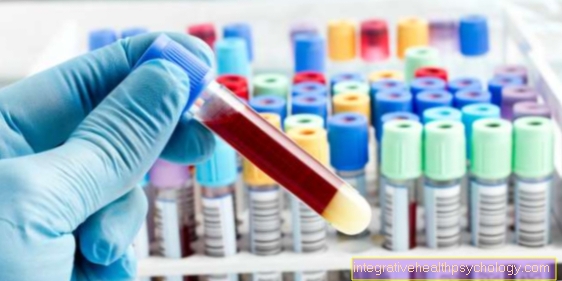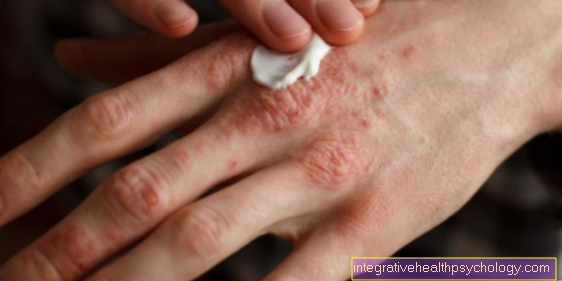The conjunctival sac
What is a conjunctival sac?
The conjunctiva is the boundary between the eye socket and the environment and starts at the edge of the eyelid. It lines the inner surface of the eyelids, forms a fold downwards and attaches to the cornea again. The conjunctival sac (Latin: conjunctival sac) is the area delimited to the outside by the fold and thus represents a cavity encased by the conjunctiva. It forms on both the upper and lower eyelids.
Due to its good absorption capacity, the lower conjunctival sac can be used to bring medication into the eye.

The anatomy of the conjunctival sac
If you want to understand the anatomical structure of the conjunctiva, you have to know the structure of the conjunctiva. This is the only way to explain the function and necessity of the conjunctival sac.
The conjunctiva, also known as the tunica conjunctiva, is a thin, vascular layer of the mucous membrane that covers the inside of the eyelids. Beginning at the edge of the eyelid to its lowest or highest point, this conjunctiva tarsi or simply "eyelid conjunctiva" is called. This is followed by an envelope fold, the conjunctiva fornicis, then the conjunctiva runs back in the starting direction as a layer covering the globe. These are also called conjunctiva bulbi. It ends when it attaches to the corneal surface.
The space delimited by the conjunctiva is also called the conjunctival sac. Since the conjunctiva is located on both the upper and lower eyelids, the binding skin sac is divided into a so-called upper and lower conjunctival vault. The lower portion is often used to bring in certain ointments and medicines.
The function of the conjunctival sac
The conjunctival sac has - in addition to the extremely practical possibility that various ointments and drops can be introduced into it - various functions that primarily protect the eye. On the one hand, it ensures that the eyeball remains mobile because it is not firmly attached to other anatomical structures. Furthermore, with the help of a smear layer of tear fluid, it enables both layers of the conjunctiva, the eyelid and bulb conjunctiva, to move against each other.
Finally, as an envelope fold, the conjunctival sac offers the perfect climate for the accumulation of lymphocytes. These are defense helpers of the immune system, which ensure that the eye does not fall ill as often and is less susceptible to infection.
The diseases of the conjunctival sac
The inflammation of the conjunctival sac
The inflammation of the conjunctival sac is often due to the conjunctivitis. The conjunctiva turns red, hurts and tears, which can cause the conjunctival sac to swell. However, there is also non-infectious inflammation of the conjunctiva and the conjunctival sac. They are mainly caused by poorly adjusted glasses and overexertion of the eye. Overexertion mainly arises from working close to the eye, when it is not given a break or when there is a lack of sleep.
But an inflamed gland on the edge of the eyelid can also affect the conjunctiva. In the case of the inner stye, a meibomian gland (special sebum gland) located on the inner edge of the eyelid and on the conjunctiva becomes inflamed. A frequent recurrence of these two diseases indicates a weakened immune system, which should be examined more closely by a doctor.
Find out all about the topic here: The conjunctivitis.
The hailstone
Hailstone, also called chalazion, is a chronic inflammation of the sebum gland on the edge of the eyelid. Over time, the slow development of inflammation creates a movable lump on the upper and lower eyelids. As a rule, this hardly hurts, since it is not a bacterial inflammation, but the body's own breakdown products in a blocked sebum gland. The eye and other structures remain largely unaffected and do not swell.
The treatment is primarily carried out by massaging the hailstone in the hope that the accumulated secretion will drain away. If this does not work, the chalazion is surgically opened and cleared.
Read more about the topic here: The hailstone.
The stye
The stye is also called the hordeolum and is a gland on the eyelid that is inflamed by bacteria. The most noticeable symptom is a reddened, painful lump on the edge of the eyelid, which is very sensitive to pressure. Triggers are staphylococci, which can be fought with red light and / or antibiotic ointments. If the inflammation does not go away on its own, it may be necessary for the doctor to open it so that the pus can drain away.
After treatment, the disease usually heals without leaving any residue. Preventive measures mainly include cleaning your hands before touching the eye. This is the only way to prevent bacteria from spreading into this protected space.
You can find more information on this topic at: The stye.
The accompanying symptoms
The pus in the conjunctival sac
If there is pus in the conjunctival sac, it is mostly conjunctivitis, which can also be accompanied by reddening and swelling of the conjunctiva. The affected eye is often stuck together.
The conjunctivitis is often triggered by bacteria and is therefore highly contagious. It is then treated with an antibiotic so that the pathogens are killed. Rinsing with chamomile can be used as a support. The spread of the disease can be prevented by good hygiene, by washing hands regularly and not sharing towels with family.
More about this topic can be found: The conjunctivitis.
The pain in the conjunctival sac
Pain in the conjunctival sac can be caused by various diseases, typically conjunctivitis, which can be triggered by bacteria or viruses. However, there can also be an allergic component if contact lenses are worn or eye drops are used. The latter are introduced into the conjunctival sac in order to achieve their effect there. However, if you are allergic to the drug introduced, pain and burning sensation in the conjunctival sac can result.
If the pain persists for more than 2-3 days, a doctor should definitely be consulted in order to prevent the inflammation from spreading and far-reaching consequences.
Which ointments are suitable for the connective skin sack?
Depending on the eye disease, it may be necessary to introduce various medications into the conjunctival sac. The above-described good capacity of the sack is used here.With the blink of an eye, the medication can be distributed in the eye from there.
In the case of bacterial infections, eye drops or ointments are mixed with an antibiotic and then introduced into the conjunctival sac. Viral diseases can usually not be treated effectively, but tear substitutes can be put into the conjunctival sac to reduce symptoms such as itching or burning. There are also disinfecting and anti-lacrimal ointments that are used for eyelid inflammation.
Above all, it is important that the hands are very well cleaned before introduction so that more pathogens do not get into the eye and the inflammation can intensify.
The lump in the connective skin sack - what's behind it?
In addition to the two diseases of the conjunctiva already described above, the hailstone and the stye, this can also be attacked by so-called chemosis. Here, the conjunctiva lifts off the dermis and swells like a bulge. A swelling develops in the conjunctival sac, which sometimes even protrudes to the outside.
Another cause of a lump on the conjunctival sac can be harmless calcification of the glandular fluid in the glands of the conjunctival sac. This calcification can be removed by an ophthalmologist under light anesthesia.
Learn more about: Chemosis of the eye.





























